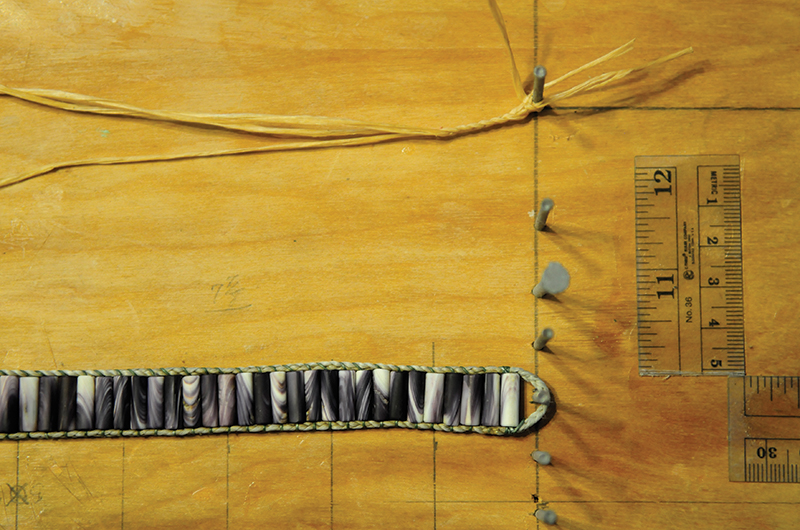Back in the seventeenth century, long before the advent of student loans and their attendant FAFSA forms, you could pay your Harvard tuition in wampum. In fact, you could pay your taxes to the Commonwealth of Massachusetts in beads as well. So what was to prevent someone from going down to the beach with a burlap sack and amassing a fortune? As Don Widdiss, Chilmark resident and wampum artisan, says, “If anyone saw how much work I put into creating a bracelet, they’d think I was crazy.”
The value of wampum, both hundreds of years ago and today, is derived from the work. To begin with, not just any shell will do. Wampum is created from the shell of the northern quahaug (occasionally the whelk shell is also used), but only select shells make the grade. They must not only be defect-free but have sufficient purple color on the inside of the shell. Also, a shell alone is not wampum. To be authentic, it must be fashioned into a bead and drilled – a process that is both delicate and time consuming. But for Don, the rewards far outweigh the effort.
“I wanted to do something with the materials of my people – to honor my Wampanoag heritage,” explains Don. “Wampum beads were traded with tribes throughout the Northeast as well as with European settlers. And for the most part, they were all made here along the coast, because this is where the shells were.”

Wampum beads were used as currency, but they had both spiritual and cultural value as well. Belts, for instance, often had beads designed into pictographs commemorating special events. Items made with wampum beads were often given as a sign of great respect.
Much wampum jewelry today is at least to some degree mass-produced, but here on the Island, the traditional craft is alive and well. And the difference between wampum jewelry handmade by Island artisans, such as Kate Taylor, Joan LeLacheur, Berta and Vernon Welch, or Don Widdiss, and mass-produced jewelry is the difference between a bespoke suit and one bought off the rack.
For Don, the process starts at Menemsha Pond. “I begin by digging the quahaugs – and of course a few littlenecks for clams casino – then I go through them all to see which ones are usable. The purple spot varies in each quahaug, but if you’re lucky you might get a big one that will yield three or four beads.”
Once you have the shells selected, you break off the areas of the shell you intend to work with, using a hammer or pliers. But from here on the work becomes extremely precise. While Don uses essentially the same techniques used by his ancestors, he bows to modernity when it comes to the use of precision tools. He begins by making a rough cut of the bead with a jeweler’s saw.
He uses a grinder to delicately shape the bead. The shells are quite fragile and there tends to be a lot of breakage. Once the bead is ground to the desired shape, it is then buffed using a polishing wheel. The quahaug shell will take on a mirror finish, so no wax or lacquer is needed.
Next the bead must be drilled so that it can be threaded together with other beads. The earliest wampum was primarily just relatively large shell pieces woven together, but along with the arrival of European settlers came metal needles and drill bits that made possible more precise craftsmanship. A delicate cylindrical bead drilled vertically would never have been possible without these tools.
Finally, the beads are threaded together; in keeping with tradition, Don weaves his own string. How the beads are arranged is left to the aesthetic judgment of the designer – there are no hard and fast rules here.
All in all, creating wampum jewelry requires considerable time and skill; honestly, it may not be for everyone. However, there is something less demanding you can make that utilizes quahaugs and has American Indian origins:
Chowder.





